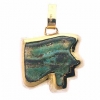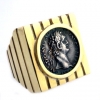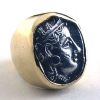|
Ancient Jewelry
|
|
 |
|
 |
|

Price :
Contact Dealer
Origin: Israel
Circa: 1600 BC to 1100 BC
Catalogue: V25
Collection: Egyptian Scarab Rings
Medium: Steatite-Gold
Additional Information: SOLD
The scarab beetle of More »
Origin: Israel
Circa: 1600 BC to 1100 BC
Catalogue: V25
Collection: Egyptian Scarab Rings
Medium: Steatite-Gold
Additional Information: SOLD
The scarab beetle of ancient Egypt is an emblem of the creator Kheper. The ward "kheper" denotes being, existence, creation or becoming and the god Khepera is the self-existent maker of all things. The worship of the scarab, which is symbolic of resurrection and fertility, dates from the earliest period of civilization in Egypt. It was thought that a sacred beetle rolled the orb of the sun across the sky, and a winged scarab was associated with dawn and rebirth. In the ritual of mummification, a scarab replaced the heart. Carved scarabs served two major functions: as amulets with protective and religious powers and as personal seals which designated the property and authority of the individual whose name was placed upon it. In both cases the power ascribed to the scarab was very great. In life it served as the signature of their owner and w as thought to bring prosperity and in the afterlife it insured continuous re-birth through eternity.
An intricate linear design highlights the under side of this ancient scarab. The center portion of the design is oval in shape, formed by double incised lines. Over these lines two heart shape sections are joined at the point. A straight line runs the length of the design, connecting the three sections together and ending in two short perpendicular lines. Delicate of shape and modeling, this fascinating pattern evidences the creative spirit that flowed from the ancient Egyptian craftsmen. The stylized carved beetle atop the scarab further displays their heightened sensitivity to the natural world. How fortunate we are to be able to enjoy today, this stunning work of ancient Egyptian art. - (FJ.5102) « Less
|
|
Ancient Jewelry
|
|
|
|
|
| Vendor Details |
Close |
| Contact Info : |
| Barakat Gallery |
| 405 North Rodeo Drive |
| Beverly Hills |
| California-90210 |
| USA |
| Email : barakat@barakatgallery.com |
| Phone : 310.859.8408 |
|
|
|
|
|
|

Price :
Contact Dealer
Origin: Lebanon (Heliopolis)
Circa: 1600 BC to 1100 BC
Collection: Egyptian Amulet
Medium: Faience/Gold
Additional Information: SOLD
The Wedjat eye was believed by the More »
Origin: Lebanon (Heliopolis)
Circa: 1600 BC to 1100 BC
Collection: Egyptian Amulet
Medium: Faience/Gold
Additional Information: SOLD
The Wedjat eye was believed by the ancient Egyptians to be the most powerful protection against evil. Ever vigilant against bad luck and misfortune, the symbolic eye of the god Horus was worn by king and peasant alike. Though the eye was sometimes fashioned in gold and precious stones, it was thought to be at its most powerful when colored blue. During Egypt's golden age, some long-forgotten person wore this lovely amulet for luck. Whoever wears it today in its golden frame will surely benefit from its ancient magic as well. - (FJ.5952) « Less
|
|
Ancient Jewelry
|
|
|
|
|
| Vendor Details |
Close |
| Contact Info : |
| Barakat Gallery |
| 405 North Rodeo Drive |
| Beverly Hills |
| California-90210 |
| USA |
| Email : barakat@barakatgallery.com |
| Phone : 310.859.8408 |
|
|
|
|
|
|

Price :
Contact Dealer
Origin: Sinai, Egypt
Circa: 1900 BC to 1300 BC
Medium: Faience
Additional Information: Sold A
Most Ancient Egyptian beads were made of faience, a glass-composite glaze More »
Origin: Sinai, Egypt
Circa: 1900 BC to 1300 BC
Medium: Faience
Additional Information: Sold A
Most Ancient Egyptian beads were made of faience, a glass-composite glaze which was introduced as early as the Pre-Dynastic period.
According to Egyptologists, such beads were made on an axis, probably of thread, which would burn up during firing, leaving a hole. Disc, ring and tubular beads were made by coating the axis with the unfired body-paste, rolling the cylinder to an even diameter on a flat surface, and then scoring it with a knife into sections of the desired length. Other shapes, such as ball beads, were rolled between the hands and perforated while still wet with a stiff point such as a wire needle. The beads were then dried, coated with glaze (if the glaze had not already been mixed with the paste), and fired. The firing process often gave the beads a beautiful translucent quality. The majority of faience beads are blue or green in color, but black, red, yellow and white ones were also produced, especially in the New Egyptian Kingdom. - (SB.0388) « Less
|
|
Ancient Jewelry
|
|
|
|
|
| Vendor Details |
Close |
| Contact Info : |
| Barakat Gallery |
| 405 North Rodeo Drive |
| Beverly Hills |
| California-90210 |
| USA |
| Email : barakat@barakatgallery.com |
| Phone : 310.859.8408 |
|
|
|
|
|
|

Price :
Contact Dealer
Origin: Egypt (Sinai)
Circa: 1900 BC to 1300 BC
Collection: Egyptian
Medium: Faience
Additional Information: SOLD
Necklace composed of genuine Egyptian faience beads More »
Origin: Egypt (Sinai)
Circa: 1900 BC to 1300 BC
Collection: Egyptian
Medium: Faience
Additional Information: SOLD
Necklace composed of genuine Egyptian faience beads dating from the Middle through New Kingdoms.
Most Ancient Egyptian beads were made of faience, a glass-composite glaze which was introduced as early as the Pre-Dynastic period. According to Egyptologists, such beads were made on an axis, probably of thread, which would burn up during firing, leaving a hole. Disc, ring and tubular beads were made by coating the axis with the unfired body-paste, rolling the cylinder to an even diameter on a flat surface, and then scoring it with a knife into sections of the desired length. Other shapes, such as ball beads, were rolled between the hands and perforated while still wet with a stiff point such as a wire needle. The beads were then dried, coated with glaze (if the glaze had not already been mixed with the paste), and fired. The firing process often gave the beads a beautiful translucent quality. The majority of faience beads are blue or green in color, but black, red, yellow and white ones were also produced, especially in the New Egyptian Kingdom. - (SB.1086) « Less
|
|
Ancient Jewelry
|
|
|
|
|
| Vendor Details |
Close |
| Contact Info : |
| Barakat Gallery |
| 405 North Rodeo Drive |
| Beverly Hills |
| California-90210 |
| USA |
| Email : barakat@barakatgallery.com |
| Phone : 310.859.8408 |
|
|
|
|
|
|

Price :
Contact Dealer
Origin: Egypt (Sinai)
Circa: 1900 BC to 1300 BC
Collection: Egyptian
Medium: Faience/Garnet
Additional Information: Sold
Necklace composed of genuine Egyptian faience More »
Origin: Egypt (Sinai)
Circa: 1900 BC to 1300 BC
Collection: Egyptian
Medium: Faience/Garnet
Additional Information: Sold
Necklace composed of genuine Egyptian faience beads dating from the Middle through New Kingdoms.
Most Ancient Egyptian beads were made of faience, a glass-composite glaze which was introduced as early as the Pre-Dynastic period.
According to Egyptologists, such beads were made on an axis, probably of thread, which would burn up during firing, leaving a hole. Disc, ring and tubular beads were made by coating the axis with the unfired body-paste, rolling the cylinder to an even diameter on a flat surface, and then scoring it with a knife into sections of the desired length. Other shapes, such as ball beads, were rolled between the hands and perforated while still wet with a stiff point such as a wire needle. The beads were then dried, coated with glaze (if the glaze had not already been mixed with the paste), and fired. The firing process often gave the beads a beautiful translucent quality. The majority of faience beads are blue or green in color, but black, red, yellow and white ones were also produced, especially in the New Egyptian Kingdom. - (SB.1101) « Less
|
|
Ancient Jewelry
|
|
|
|
|
| Vendor Details |
Close |
| Contact Info : |
| Barakat Gallery |
| 405 North Rodeo Drive |
| Beverly Hills |
| California-90210 |
| USA |
| Email : barakat@barakatgallery.com |
| Phone : 310.859.8408 |
|
|
|
|
|
|

Price :
Contact Dealer
Origin: Sinai
Circa: 1650 BC to 1085 BC
Medium: Faience
Additional Information: SOLD
Necklace consisting of genuine antique faience beads dating from the New Egyptian More »
Origin: Sinai
Circa: 1650 BC to 1085 BC
Medium: Faience
Additional Information: SOLD
Necklace consisting of genuine antique faience beads dating from the New Egyptian Kingdom. - (FB.0129) « Less
|
|
Ancient Jewelry
|
|
|
|
|
| Vendor Details |
Close |
| Contact Info : |
| Barakat Gallery |
| 405 North Rodeo Drive |
| Beverly Hills |
| California-90210 |
| USA |
| Email : barakat@barakatgallery.com |
| Phone : 310.859.8408 |
|
|
|
|
|
|

Price :
$2700.00
Origin: Mediterranean
Circa: 81 AD to 96 AD
Collection: Coin Jewelry
Style: Roman
Medium: Silver and Gold
Additional Information: The coin was found in Samaria, More »
Origin: Mediterranean
Circa: 81 AD to 96 AD
Collection: Coin Jewelry
Style: Roman
Medium: Silver and Gold
Additional Information: The coin was found in Samaria, Israel.
This genuine Ancient Roman coin has been mounted in a modern 18 karat gold ring.The monuments that Domitian erected in Rome —the Colosseum and the Imperial Residence on the Palatine Hill— till stand impressively today. This ring—combining the Classic with the contemporary—is ideal for someone who wants to male a lasting impression on the world. - (FJ.2099) « Less
|
|
Ancient Jewelry
|
|
|
|
|
| Vendor Details |
Close |
| Contact Info : |
| Barakat Gallery |
| 405 North Rodeo Drive |
| Beverly Hills |
| California-90210 |
| USA |
| Email : barakat@barakatgallery.com |
| Phone : 310.859.8408 |
|
|
|
|
|
|

Price :
$4600.00
Origin: Island of Rhodes
Circa: 490 BC to 322 BC
Collection: Coin Jewelry
Style: Greek Coin Rings
Medium: Silver and Gold
During the Classical Age, the silver coins of More »
Origin: Island of Rhodes
Circa: 490 BC to 322 BC
Collection: Coin Jewelry
Style: Greek Coin Rings
Medium: Silver and Gold
During the Classical Age, the silver coins of Athens were particularly prized for their quality and their beauty. Looking at this superb example, even after the passage of centuries, it is easy to understand why. The owl, sacred bird of the goddess Athena and symbol of wisdom, that adorns this tetradrachm is an appropriate image. Whoever wears this superb ring will be wise indeed, and timelessly in fashion. - (FJ.2839) « Less
|
|
Ancient Jewelry
|
|
|
|
|
| Vendor Details |
Close |
| Contact Info : |
| Barakat Gallery |
| 405 North Rodeo Drive |
| Beverly Hills |
| California-90210 |
| USA |
| Email : barakat@barakatgallery.com |
| Phone : 310.859.8408 |
|
|
|
|
|
|

Price :
Contact Dealer
These two ancient coins are mounted in an incomparable necklace comprising two 18-karat gold pendants and an 18-karat gold clasp, strung with four strands of genuine emerald More »
These two ancient coins are mounted in an incomparable necklace comprising two 18-karat gold pendants and an 18-karat gold clasp, strung with four strands of genuine emerald beads. The gold elements are set with 194 genuine diamonds with a total weight of 7.34 carats. The clasp is set with an emerald weighing 2.13 carats.Silver coins of two of history's great monarchs are at the heart of this magnificent necklace. Its glowing beauty, its exquisite craftsmanship, and its rarity would have sparked the admiration of any age, whether past or present. It would have caused a sensation in the palaces of Alexandria or the court of Rome, just as it will dazzle wherever it is worn today. Classical adornment, destined for a woman who is equally one-of-a- kind. - (FJ.3166) « Less
|
|
Ancient Jewelry
|
|
|
|
|
| Vendor Details |
Close |
| Contact Info : |
| Barakat Gallery |
| 405 North Rodeo Drive |
| Beverly Hills |
| California-90210 |
| USA |
| Email : barakat@barakatgallery.com |
| Phone : 310.859.8408 |
|
|
|
|
|
|

Price :
Contact Dealer
Origin: Mediterranean
Circa: 336 BC to 323 BC
Catalogue: V7
Collection: Jewelry
Style: Greek
Medium: Silver, Gold
Additional Information: This coin was found in Asia More »
Origin: Mediterranean
Circa: 336 BC to 323 BC
Catalogue: V7
Collection: Jewelry
Style: Greek
Medium: Silver, Gold
Additional Information: This coin was found in Asia Minor.
This genuine ancient coin of Alexander the Great has been mounted in a dazzling modern 18 karat gold necklace set with 502 genuine diamonds with a total weight of 27.34 carats. The lozenge-shaped beads are topped with 24 karat gold, and the pendant is adorned with an African emerald.Throughout history, in every great civilization, beautiful women have adorned themselves with rare and precious jewels. Such treasures possess a timeless appeal, weaving a magic spell around the heart. The wearing of great jewels is an emotional experience, delighting the soul as well as the senses. With a coin of the fabled Alexander at its center, this remarkable necklace is the stuff from which legends are born. The woman who wears it will make a dramatic statement without uttering a word. - (FJ.3587) « Less
|
|
Ancient Jewelry
|
|
|
|
|
| Vendor Details |
Close |
| Contact Info : |
| Barakat Gallery |
| 405 North Rodeo Drive |
| Beverly Hills |
| California-90210 |
| USA |
| Email : barakat@barakatgallery.com |
| Phone : 310.859.8408 |
|
|
|
|
|
|
|
|

|


